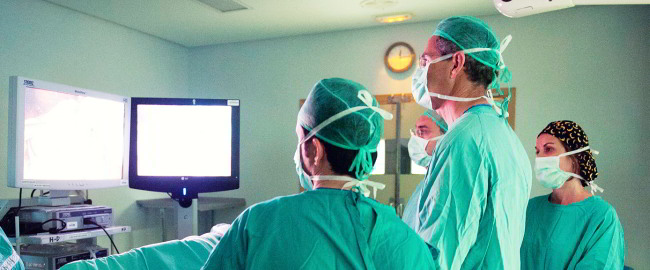La clinica
Laparoscopic surgery
Mininvasive laparoscopic surgery: Single assisted port
Mini-invasive laparoscopy allows us to perform the same operations “inside the abdomen”, but causing fewer injuries and sequelae in the body.
We are pioneers in Spain in the application of this variant technique for obesity operations. We have intervened more than 30 patients with excellent results.
Laparoscopic surgery began to be applied effectively in the 90’s and, except in isolated cases, began to be used in obesity surgery from the year 2000. We began with laparoscopic obesity surgery in 2003. In Spain, it has not yet become sufficiently widespread. Actually, no obese patient should be intervened in primary surgery or by revision surgery, by means of laparotomy (opening the abdomen), due to the greater risk that it supposes for the obese patient. When a surgical team does not have sufficient laparoscopic training, it must refer the patient to a referral centre.
In addition, methodologies known as mini-invasives have been developed within laparoscopy, both for surgery and for anaesthesia. To be familiar to you, it deals with the “single port” or “assisted single port” system, advanced instrumentation that minimizes tissue damage during manipulation, advanced suturing, stapling and haemostasis methods, infiltration and anaesthetic instillation of the abdomen, anaesthesia using fast-absorbing pharmacology, advanced intubation systems, no use of central lines, bladder or nasogastric catheters.
Only the use of this technology allows the application of Fast-Track rapid recovery protocols.

Advantages of mini-invasive laparoscopic surgery
- Less aggression to the organism.
- Less discomfort, facilitating respiratory and digestive recovery.
- 48 hours of hospital admission.
- Faster recovery for incorporation into normal life.
- Minimal aesthetic sequelae.
Consult us about your case, through our virtual consultation on obesity.
How is the operation performed?
The main point of entry is the navel, so that the scar will remain inside without being appreciated.
Through this umbilical trocar (orifice), the main instruments are introduced, and the stomach pocket is removed at the end of the operation.
In addition, we use 2 or 3 microincisions of 3-4mm, in order to reproduce “inside”, the same operation as before and identical safety.

What operations do we carry out using this method?
- Tubular Gastrectomy.
- Gastric Plication.
- The Gastric Band.
Is there any difference in "the way the operation is performed inside"?
None, and there should not be any difference. The result of the operation, in terms of safety and weight lost, must be the same or better than by conventional laparoscopy.
Some teams are forced to modify the technique, in order to apply the single port, and it should not be done!
How does the patient notice the improvement?
- Less postoperative discomfort, less need for analgesics.
- It facilitates the walks and breathing exercises, the same day of the operation.
- Less chance of thrombosis.
- Less feeling of severity and worry.
- The patient drinks the afternoon of the operation.
- Stay in the hospital for 2 days.
- Quicker return to normal life.
Can it be applied to all patients?
Limitations are less and less. Currently not used in patients with superobesity and revision operations.
Does this technique have a higher cost?
In our Clinic, we use the best possible technique for each patient, without modifying the medical fees.
What are the disadvantages of laparoscopic surgery?
It is only necessary to start with these techniques, teams with long experience in obesity surgery.
Even so, it is not always possible to perform it with sufficient safety, and conventional laparoscopic surgery must be resumed.









